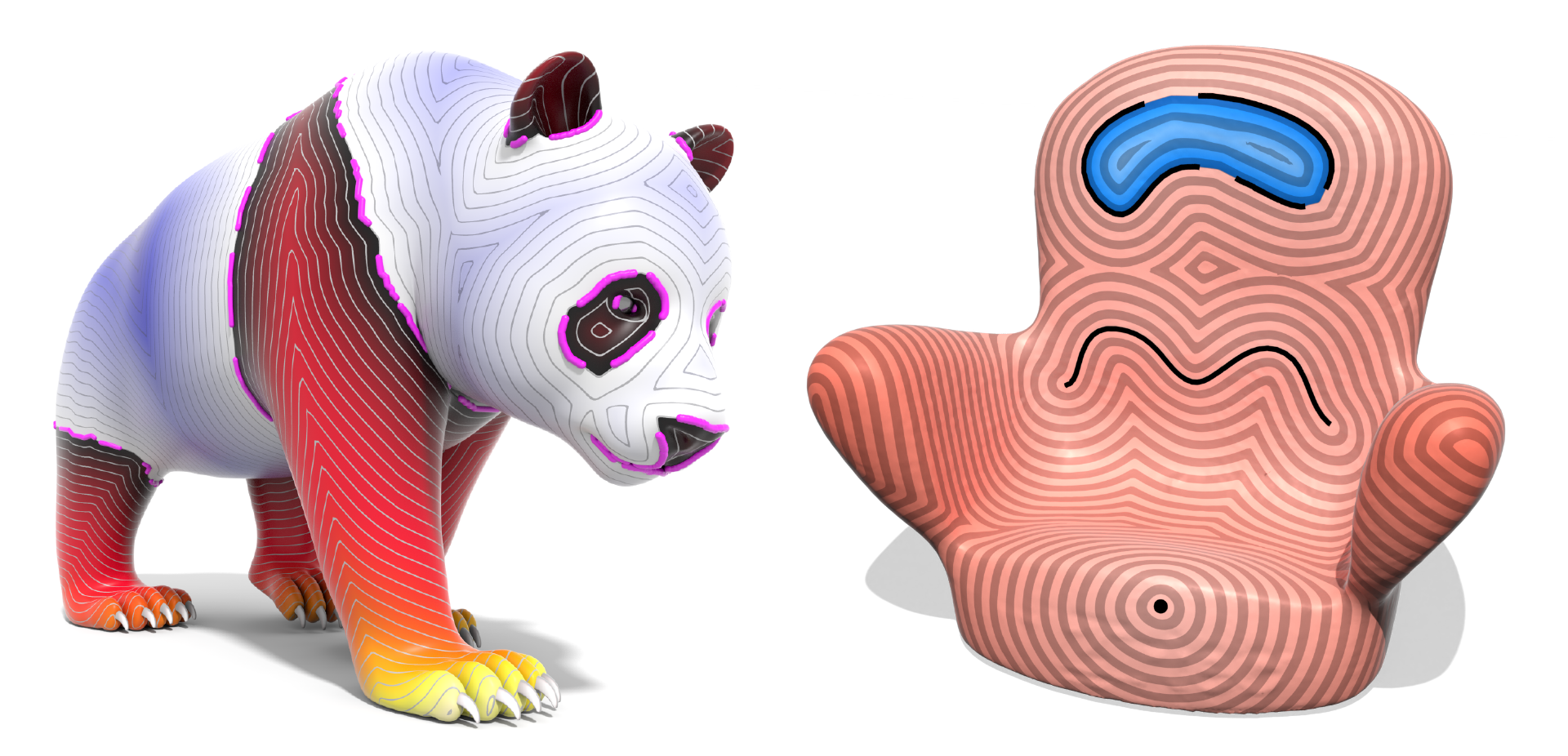Signed Heat Method
This section describes the Signed Heat Method in geometry-central, which computes signed and unsigned distance to possibly broken geometry using heat flow.
Note that these quantities all depend on the intrinsic geometry of a surface (via the IntrinsicGeometryInterface). Therefore, these routines can be run on abstract geometric domains as well as traditional surfaces in 3D.
This algorithm is described in A Heat Method for Generalized Signed Distance.
#include "geometrycentral/surface/signed_heat_method.h"
For the polygon mesh version, see the polygon mesh heat solver; for point clouds, see the point cloud heat solver.
Signed Heat Solver
The stateful class SignedHeatSolver shares precomputation for all of the routines below. What this means is that later solves may become significantly faster, as precomputation occurs on earlier solves.
SignedHeatSolver::SignedHeatSolver(IntrinsicGeometryInterface& geom, double tCoef=1.0)
Create a new solver for the Signed Heat Method. Precomputation is performed lazily as needed.
-
geomis the geometry (and hence mesh) on which to compute. Note that nearly any geometry object (VertexPositionGeometry, etc) can be passed here. -
tCoefis the time to use for short time heat flowtCoef * h^2, wherehis the mean distance between nodes of the mesh. The default value of1.0is almost always sufficient.
Signed & Unsigned Geodesic Distance

Example:
#include "geometrycentral/surface/signed_heat_method.h"
// your mesh and geometry
VertexPositionGeometry geometry;
SurfaceMesh mesh;
// construct a solver
SignedHeatSolver signedHeatSolver(geometry);
// specify some source geometry
std::vector<Curve> curves;
curves.emplace_back();
curves.back().nodes.emplace_back(mesh.vertex(0));
curves.back().nodes.emplace_back(mesh.edge(5), 0.3);
// solve!
VertexData<double> distance = signedHeatSolver->computeDistance(curves);
VertexData<double> SignedHeatSolver::computeDistance(const std::vector<Curve>& curves, const std::vector<SurfacePoint>& points, const SignedHeatOptions& options = SignedHeatOptions())
Compute distance to a collection of curves and points. Curves may be a source of either signed or unsigned distance (see Curve object below.) Points are given as a list of surface points to which we compute unsigned distance.
VertexData<double> SignedHeatSolver::computeDistance(const std::vector<Curve>& curves, const SignedHeatOptions& options = SignedHeatOptions())
Compute distance to a collection of curves. Curves may be a source of either signed or unsigned distance (see Curve object below.)
VertexData<double> SignedHeatSolver::computeDistance(const std::vector<SurfacePoint>& points, const SignedHeatOptions& options = SignedHeatOptions())
Compute unsigned distance to a collection of isolated point sources. Point sources are given as a list of surface points.
The diffusion time can also be changed using the following function.
void SignedHeatSolver::setDiffusionTimeCoefficient(double tCoef)
Re-computes the time used for short time heat flow tCoef * h^2, where h is the mean distance between nodes of the mesh.
Note: On triangle meshes, each mesh edge crossed by an input curve should be explicitly represented by a SurfacePoint (otherwise the curve’s geometry is not fully specified). If this is not the case, the code internally partitions input curves so that this condition is satisfied; the robustness of the heat method should fill in small gaps. Depending on how sparsely your curve is sampled, this may produce curve components with fewer than two nodes, which will be ignored; if many of your curves have fewer than two nodes, consider FlipOut geodesics for shortest-path completion of curves.
Helper Types
Curves
| Field | Default value | Meaning |
|---|---|---|
std::vector<SurfacePoint> nodes |
std::vector<SurfacePoint>() |
The nodes of the curve, given as an ordered sequence of surface points. |
bool isSigned |
true |
Whether the curve is oriented or not. If isSigned is true, then (generalized) signed distance will be computed to the curve; unsigned distance otherwise. |
Options
Options are passed in to computeDistance via a SignedHeatOptions struct, which has the following fields.
| Field | Default value | Meaning |
|---|---|---|
bool preserveSourceNormals |
false |
If true, preserve the initial curve normals at the source curve during vector diffusion. |
LevelSetConstraint levelSetConstraint |
LevelSetConstraint::ZeroSet |
Specifies how/if level sets should be preserved. Can be set to LevelSetConstraint::ZeroSet, LevelSetConstraint::Multiple, or LevelSetConstraint::None, corresponding to preservation of the input curves as the zero set, as multiple level sets (one for each curve component), or no constraint, respectively. |
double softLevelSetWeight |
-1 |
If greater than 0, gives the weight with which the given level set constraint is “softly” enforced. |
Citation
If these algorithms contribute to academic work, please cite the following paper:
@article{Feng:2024:SHM,
author = {Feng, Nicole and Crane, Keenan},
title = {A Heat Method for Generalized Signed Distance},
year = {2024},
issue_date = {August 2024},
publisher = {Association for Computing Machinery},
address = {New York, NY, USA},
volume = {43},
number = {4},
issn = {0730-0301},
url = {https://doi.org/10.1145/3658220},
doi = {10.1145/3658220},
journal = {ACM Trans. Graph.},
month = {jul},
articleno = {92},
numpages = {19}
}